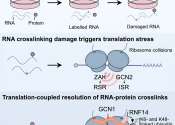Chemotherapy, in its most general sense, refers to treatment of disease by chemicals that kill cells, both good and bad, but specifically those of micro-organisms or cancerous tumours. In popular usage, it refers to antineoplastic drugs used to treat cancer or the combination of these drugs into a cytotoxic standardized treatment regimen. In its non-oncological use, the term may also refer to antibiotics (antibacterial chemotherapy). In that sense, the first modern chemotherapeutic agent was Paul Ehrlich's arsphenamine, an arsenic compound discovered in 1909 and used to treat syphilis. This was later followed by sulfonamides discovered by Domagk and penicillin discovered by Alexander Fleming.
Most commonly, chemotherapy acts by killing cells that divide rapidly, one of the main properties of cancer cells. This means that it also harms cells that divide rapidly under normal circumstances: cells in the bone marrow, digestive tract and hair follicles; this results in the most common side effects of chemotherapy—myelosuppression (decreased production of blood cells), mucositis (inflammation of the lining of the digestive tract) and alopecia (hair loss).
Other uses of cytostatic chemotherapy agents (including the ones mentioned below) are the treatment of autoimmune diseases such as multiple sclerosis and rheumatoid arthritis and the suppression of transplant rejections (see immunosuppression and DMARDs). Newer anticancer drugs act directly against abnormal proteins in cancer cells; this is termed targeted therapy.









